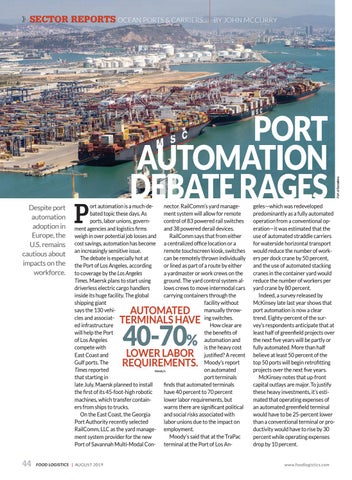Despite port automation adoption in Europe, the U.S. remains cautious about impacts on the workforce.
P
PORT AUTOMATION DEBATE RAGES
ort automation is a much-denector. RailComm’s yard managebated topic these days. As ment system will allow for remote ports, labor unions, governcontrol of 83 powered rail switches and 38 powered derail devices. ment agencies and logistics firms RailComm says that from either weigh in over potential job losses and cost savings, automation has become a centralized office location or a remote touchscreen kiosk, switches an increasingly sensitive issue. can be remotely thrown individually The debate is especially hot at or lined as part of a route by either the Port of Los Angeles, according a yardmaster or work crews on the to coverage by the Los Angeles ground. The yard control system alTimes. Maersk plans to start using driverless electric cargo handlers lows crews to move intermodal cars inside its huge facility. The global carrying containers through the shipping giant facility without says the 130 vehimanually throwcles and associating switches. How clear are ed infrastructure the benefits of will help the Port automation and of Los Angeles is the heavy cost compete with justified? A recent East Coast and Moody’s report Gulf ports. The on automated Times reported Moody’s port terminals that starting in finds that automated terminals late July, Maersk planned to install have 40 percent to 70 percent the first of its 45-foot-high robotic lower labor requirements, but machines, which transfer containwarns there are significant political ers from ships to trucks. and social risks associated with On the East Coast, the Georgia labor unions due to the impact on Port Authority recently selected RailComm, LLC as the yard manage- employment. Moody’s said that at the TraPac ment system provider for the new Port of Savannah Multi-Modal Con- terminal at the Port of Los An-
AUTOMATED TERMINALS HAVE
40-70%
LOWER LABOR REQUIREMENTS.
44
FOOD LOGISTICS | AUGUST 2019
FLOG0819_44-47_Ocean_JY.indd 44
BY JOHN MCCURRY
Port of Barcelona
SECTOR REPORTS OCEAN PORTS & CARRIERS
geles—which was redeveloped predominantly as a fully automated operation from a conventional operation—it was estimated that the use of automated straddle carriers for waterside horizontal transport would reduce the number of workers per dock crane by 50 percent, and the use of automated stacking cranes in the container yard would reduce the number of workers per yard crane by 80 percent. Indeed, a survey released by McKinsey late last year shows that port automation is now a clear trend. Eighty-percent of the survey’s respondents anticipate that at least half of greenfield projects over the next five years will be partly or fully automated. More than half believe at least 50 percent of the top 50 ports will begin retrofitting projects over the next five years. McKinsey notes that up-front capital outlays are major. To justify these heavy investments, it’s estimated that operating expenses of an automated greenfield terminal would have to be 25-percent lower than a conventional terminal or productivity would have to rise by 30 percent while operating expenses drop by 10 percent.
www.foodlogistics.com
7/31/19 3:47 PM

